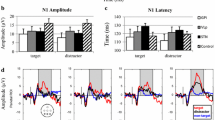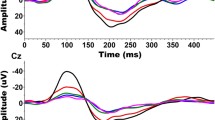Summary
Animal models of event related potentials (ERPs) have recently been developed in order to gain further understanding of the psychobiological variables which may underlie these brain potentials. In the present study, unanaesthetized rats were utilized in order to evaluate the effects on rat ERP morphology of changes in the auditory stimulus parameters used to elicit these potentials such as tone probability and intensity. In addition, the consequences of reductions in norepinephrine (NE) produced by six-hydroxydopamine (6-OHDA) lesions to the area of the dorsal noradrenergic bundle in ERP wave forms were evaluated. Forty, experimentally naive, male rats chronically implanted with electrodes were used in this study. The results of these studies showed that in all electrode sites (frontal cortex, ventral thalamus, dorsal hippocampus, locus coeruleus) a series of large amplitude potentials in the 10–200 msec latency range could be recorded, some of which were sensitive to changes in the auditory stimulus parameters such as probability and tone intensity. Late positive potentials in the 300–400 msec range could be identified in recordings from the dorsal hippocampus and were found to be sensitive to probability independent of tone intensity. Dorsal noradrenergic bundle lesions were also found to produce significant changes in these rat ERP components. Lesioned animals were found to have increases in amplitude to the early negative potentials (in the 50–100 msec range) in response to frequent tones in cortical leads and decreases in the amplitude of the late positive potentials (in the 300–400 msec range) recorded in hippocampal leads in response to infrequent tones. These findings are consistent with a role for NE in the forebrain in the processing of novel or “selective” stimuli.
Similar content being viewed by others
References
Arthur DL, Starr A (1984) Task-relevant late positive component of the auditory event-related potential in monkeys resembles P300 in humans. Science 223: 186–188
Buchwald JS, Squires NS (1982) Endogenous auditory potentials in the cat: a P300 model. In: Woody C (ed) Conditioning: representation of involved neural function. Raven Press, New York, pp 503–515
Courchesne E (1978a) Neurophysiological correlates of cognitive development: changes in long-latency event-related potentials from childhood to adulthood. Electroencephalogr Clin Neurophysiol 45: 468–482
Courchesne E (1978b) Changes in P3 waves with event repetition: long-term effects on scalp distribution and amplitude. Electroencephalogr Clin Neurophysiol 45: 754–766
Desmedt JE, Debecker J (1979) Wave form and neural mechanism of the decision P350 elicited without prestimulus CNV or readiness potentials in random sequences of near-threshold auditory clicks and finger stimuli. Electroencephalogr Clin Neurophysiol 47: 648–670
Donchin E, Ritter W, McCallum WC (1978) Cognitive psychophysiology: the endogenous components of the ERP. In: Callaway E, Tueting P, Koslow SH (eds) Event related brain potentials in man. Academic Press, New York, pp 349–411
Donchin E, Karis D, Bashore TK, Coles MGH, Gratton G (1986) Cognitive psychophysiology and human information processing. In: Coles MGH, Donchin R, Porges SW (eds) Psychophysiology systems, processes, and applications. The Guilford Press, New York, pp 244–267
Ehlers CL (1988) ERP responses to ethanol and diazepam administration in squirrel monkeys. Alcohol 5: 315–320
Ehlers CL (1989) EEG and ERP responses to naloxone and ethanol in monkeys. Prog Neuropsychopharmacol Biol Psychiatry 13: 217–228
Ehlers CL, Wall TL, Chaplin RI (1991a) Long latency event related potentials in rats: effects of dopaminergic and serotonergic depletions. Pharmacol Biochem Behav 38 (4): 789–793
Ehlers CL, Chaplin RI, Lumeng L, Li TK (1991b) Electrophysiological response to ethanol in P and NP rats. Alcohol: Clin Exp Res (15)4: 739–744
Ehlers CL, Chaplin RI (1991c) EEG and ERP response to chronic ethanol exposure in rats. Psychopharmacology 104: 67–74
Foote SL, Bloom FE (1979) Activity of norepinephrine-containing locus coeruleus neurons in the unanaesthetized squirrel monkey. In: Usdin E, Kopin I, Barachas J (eds) Catecholamines: basic and clinical frontiers. Pergamon Press, New York, pp 625–627
Foote SL, Bloom FE, Aston-Jones G (1983) Nucleus locus coeruleus: new evidence of anatomical and physiological specificity. Physiol Rev 63: 844–914
Glover AA, Onofrj MC, Ghilardi MF, Bodis-Wollner I (1986) P300-like potentials in the normal monkey using classical condition and an auditory “oddball” paradigm. Electroencephalogr Clin Neurophysiol 65: 231–235
Goff ER, Allison T, Vaughn Jr HG (1978) The functional neuroanatomy of event-related potentials. In: Tueting EP, Koslow SH (eds) Event-related potentials in man. Academic Press, New York, pp 1–79
Halgren E, Squires NK, Wilson CL, Rohrbaugh JW, Babb TL, Crandall PH (1980) Endogenous potentials generated in the human hippocampal formation and amygdala by infrequent events. Science 210: 803–805
Harrison J, Buchwald J (1985) Aging changes in the cat “P300” mimic the human. Electroencephalogr Clin Neurophysiol 62: 227–234
Harrison J, Buchwald J, Kaga K (1986) Cat P300 present after primary cortex ablation. Electroencephalogr Clin Neurophysiol 63: 180–187
Harrison J, Buchwald J, Kaga K, Woolf NJ, Bucher L (1988) Cat P300 disappears after septal lesions. Electroencephalogr Clin Neurophysiol 69: 55–64
Hillyard SA, Kutas M (1983) Electrophysiology of cognitive processing. Ann Rev Psychol 34: 34: 32–61
Hurlbut BJ, Jubar JF, Satterfield SM (1987) Auditory elicitation of the P300 event-related potential in the rat. Physiol Behav 39: 483–487
Kilts CD, Anderson CM (1986) The simultaneous quantification of dopamine, norepinephrine and epinephrine in micro punched rat nuclei by online trace enrichment HPLC with electrochemical detection: distribution of catecholamines in the limbic system. Neurochem Int 9 (3): 437–445
Knight RT, Scabin P, Woods DL, Clayworth CC (1989) Contributions of temporal-parietal junction of the human auditory P3. Brain Res 502: 109–116
Koob GF, Thatcher-Britton K, Britton DR, Roberts DCS, Bloom FE (1984) Destruction of the locus coeruleus or the dorsal NE bundle does not alter the release of punished responding by ethanol and chlordiazepoxide. Physiol Behav 33: 479–485
McCarthy G, Wood CC, Allison T, Goff WR, Williamson PD, Spencer DD (1982) Intercranial recordings of event-related potentials in humans engaged in cognitive tasks. Soc Neurosci Abstr 8: 976
Neville HL, Foote SL (1984) Auditory event-related potentials in the squirrel monkey: parallels to human late-wave responses. Brain Res 298: 107–116
O'Brien JH (1982) P300 wave elicited by a stimulus-change paradigm in acutely prepared rats. Physiol Behav 28: 711–713
Pellegrino LJ, Pellegrino AS, Cushman AJ (1979) A stereotaxic atlas of the rat brain. New York, Plenum Press
Pineda JA, Foote SL, Neville HJ (1987) Long-latency event-related potentials in squirrel monkeys: further characterization of waveform morphology, topography, and functional properties. Electroencephalogr Clin Neurophysiol 67: 77–90
Pineda JA, Foote SL, Neville HJ (1989) Effects of locus coeruleus lesions on auditory, long-latency, event-related potentials in monkeys. J Neurosci 9(1): 81–89
Polich J (1987a) Comparison of P300 from a passive tone sequence paradigm and an active discrimination task. Psychophysiology 24(1): 41–46
Polich J (1987b) Task difficulty, probability, and inter-stimulus interval as determinants of P300 from auditory stimuli. Electroencephalogr Clin Neurophysiol 68: 311–320
Polich J, Donchin E (1988) P300 and the work frequency effect. Electroencephalogr Clin Neurophysiol 70: 33–45
Polich J, Fischer A, Starr A (1983) A programmable multi-tone generator. Behav Res Methods Instrum 15 (1): 39–41
Ritter W, Vaughan Jr HG, Costa LD (1968) Orienting and habituation to auditory stimuli: a study of short term changes in average evoked responses. Electroencephalogr Clin Neurophysiol 25: 550–556
Robbins TW (1984) Cortical noradrenaline attention and arousal. Psychol Med 14: 13–21
Roth WT (1973) Auditory evoked responses to unpredictabe stimuli. Psychophysiology 10: 125–137
Roth WT, Ford JM, Lewis SJ, Kopel BS (1976) Effects of stimulus probability and task-relevance on event-related potentials. Psychophysiology 13: 311–317
Roth WT, Doyle CM, Pfefferbaum A, Kopell BS (1980) Effects of stimulus intensity on P300. In: Kornhuber HH, Deecke L (eds) Motivation, motor and sensory processes of the brain: electrical potentials, behaviour, and clinical use, vol 54. Elsevier, Amsterdam, pp 296–300
Squires NK, Squires KC, Hillyard SA (1975) Two varieties of long latency positive waves evoked by unpredictable auditory stimuli in man. Electroencephalogr Clin Neurophysiol 38: 387–401
Sutton S, Braren M, Zubin J, John ER (1965) Evoked-potential correlates of stimulus uncertainty. Science 150: 1187–1188
Wood CC, Allison T, Goff WR, Williamson PD, Spencer DD (1980) On the neural origin of P300 in man. Prog Brain Res 54: 51–56
Wood CC, McCarthy G (1986) A possible frontal lobe contribution to scalp P300. In: Rohrbaugh JW, Johnson Jr R, Parasuraman R (eds) Eighth International Conference on Event-Related Potentials of the Brain (EPIC VIII: Research Reports). Stanford, California, pp 164–166
Author information
Authors and Affiliations
Rights and permissions
About this article
Cite this article
Ehlers, C.L., Chaplin, R.I. Long latency event related potentials in rats: The effects of changes in stimulus parameters and neurochemical lesions. J. Neural Transmission 88, 61–75 (1992). https://doi.org/10.1007/BF01245037
Received:
Accepted:
Issue Date:
DOI: https://doi.org/10.1007/BF01245037




